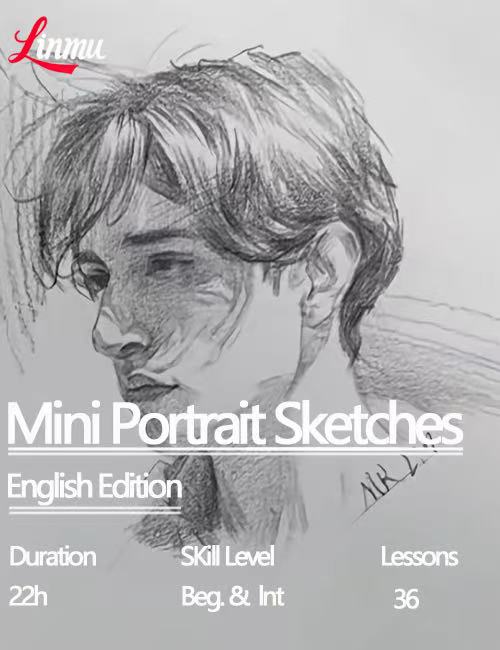Linmu – Mini Portrait Sketches

About Course
Phase 1: Quick Character Sketching Method
(Mini Portrait Sketches, New 3.0 International Edition)
This phase covers fundamental portrait proportions, perspectives, three-views, and the Loomis method. Students practice 2-3 minute sketches to master figure proportions and dynamics
Phase 2: Quick Character Sketching Method
Focus on observing and depicting facial features and hair. Students enhance their sensitivity to character traits through quick observation exercises, and study the key structural elements of facial features.
Phase 3: Quick Character Sketching Method
Students engage in 6-minute line sketch exercises, applying previous techniques to capture distinctive features and improve sketching speed.
Phase 4: Mini Portrait Sketches
Integrate internal character structures with practical drawing techniques, including three-view skull illustrations and muscle-expression relationships. By working on full compositions, students gain an understanding of how to depict skeletal and muscular structures effectively.
Phase 5: Mini Portrait Sketches
Consolidate previous learning, focus on light effects on facial features and understand light source representation. Practice small color sketches of characters, focusing on overall lighting effects rather than details.
Strengthen understanding of individual facial features by teaching detailed rendering techniques. Students learn about the massing of individual facial features and their relationship with light sources.
Phase 6: Complete Composition for Mini Portraits
Practice complete compositions by integrating all previously learned knowledge, portraying diverse characters from various angles, ages, and genders. Learn to depict children’s innocence and softness of female.
Course Content
1.Introduction and Use of Drawing Tools
-
10:02
-
1.Introduction and Use of Drawing Tools-2
12:34
2.Basic Proportions and Structure of Human Head
3.Multi-angle Head Proportion Practice
4.Multiple Character Proportion and Facial Dynamic Practice
5.Perspective Rules for Characters
6.Multi-angle Character Dynamics
7.Multiple Character Line Drawing Practice 1
8.Multiple Character Line Drawing Practice 2
9.Multiple Character Line Drawing Practice 3
10.Multiple Character Line Drawing Practice 4
11.Observation Method Practice For A Single Eye
12.Observation Method Practice For A Set of Eyes
13.Observation Method Practice For Nose
14.Observation Method Practice For Ear
15.Observation Method Practice For Mouth
16.Observation and Drawing Methods For Different Hairstyles
17.Multiple Character Line Drawing Practice 1
18.Multiple Character Line Drawing Practice 2
19.Front-view Young Male Complete Sketch Basic Practice
20.Head-up Young Male Complete Sketch Basic Practice
21.Relationship Between Facial Expressions and Muscles
22.Relationship Between Massing of Facial Muscle and Light Source
23.Light Source Influence in Drawing
24.Character Light Source Local Color Sketch Practice 1
25. Character Light Source Local Color Sketch Practice 2
26. Three-view Explanation For Skulls
27. Complete Drawing Demonstration for Single Eye
28. Complete Drawing Demonstration A Set of Eyes
29.Complete Drawing Demonstration For Mouth
30.Complete Ear Drawing Demonstration
31.Complete Hair Drawing Demonstration
32.Complete Character Practice: Child
33.Complete Character Practice: Young Male
34.Complete Character Practice: Young Female
35.Complete Character Practice: Elderly
36.Appreciation of Excellent Works and Independent Creation Practice Methods
Student Ratings & Reviews
